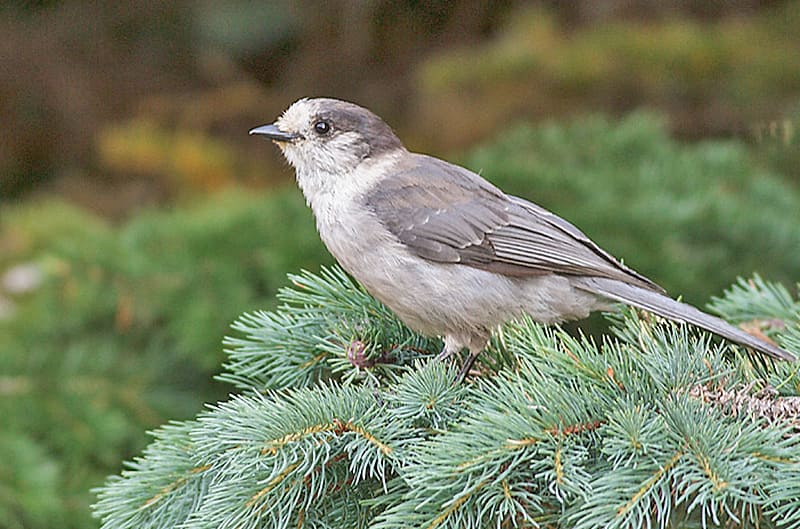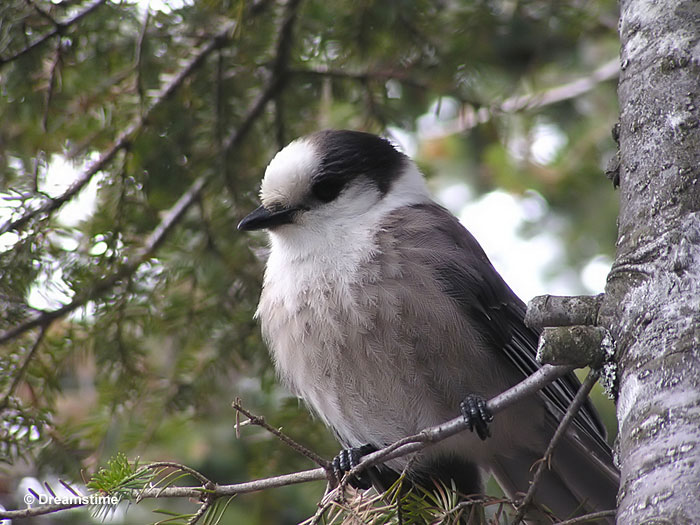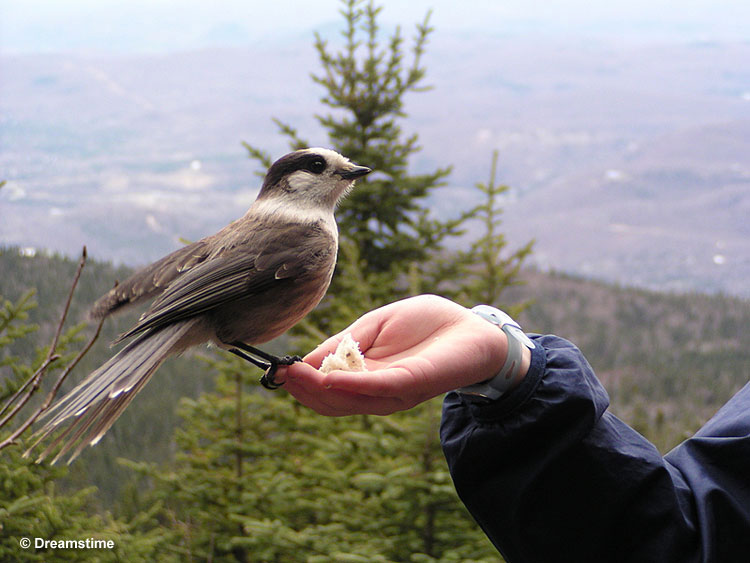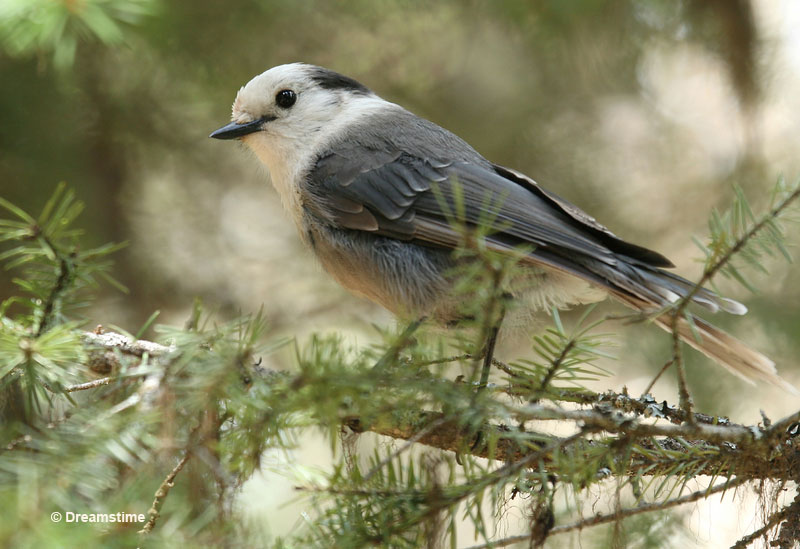Meet the mischievous and intelligent Canada Jay (Perisoreus canadensis), previously known as Gray Jay.
People have also named it the “camp robber” for its bold behavior of stealing food from unsuspecting campers.
These birds are known for their playful antics and acrobatic abilities as they deftly navigate through the coniferous forests of North America.
On this page
What Does A Canada Jay Look Like?
Male and female Canada Jays look the same, although the males are slightly larger than the females. They are relatively large songbirds that can grow up to 9.8-13 inches long and have a wingspan of 17-18 inches.
Canada Jays’ plumage is a mix of grays, blacks, and whites. They have a dark gray or black nape, wings, and tail, light gray belly and white cheeks, throat, and forehead. Their eyes, legs, and short and slender bill are also black. The juvenile Canada Jays have an overall dark gray plumage with a lighter-colored bill tipped with black.
Birds located in the eastern United States have slightly paler plumage than the birds inhabiting the Rocky Mountains.

Photograph © Glenn Bartley.
Where Are Canada Jays Found?
Canada Jays range in the Nearctic region from the northern tip of Alaska to as far south as Arizona. They are a non-migratory species across their range, although the birds that live on higher mountains are known to move to lower elevations for the winter.
They are common throughout Canada but in the United States, they are most commonly found in the Rocky Mountains to New Mexico and Arizona and on the northwest coast.
Where Do Canada Jays Live?
Canada Jay’s habitat key requirements include sufficiently cold temperatures to store food that would otherwise perish and tree bark that offers places to hide and attach them to.
That’s why they primarily live in mature, boreal, and sub-alpine coniferous forests and are most often found over an elevation of 3,000 feet and above the tree line.
They prefer spruce and fir forests but are also found in different coniferous and mixed forests. In eastern Canada, they live in black spruce bogs, in the Rocky Mountains they inhabit aspen and Engelmann spruce forests and on the northwest coast, they can be seen in Sitka spruce and Douglas-fir forests.
They thrive near permanent bodies of fresh water, from small ponds to big lakes.

What Do Their Nests Look Like?
A Canada Jay’s nest is often around 15 feet up a dense conifer tree, close to the trunk at the base of a branch.
The male starts building the bulky cup-like nest, weaving twigs and strips of bark together, while the female finishes it, lining it with softer materials such as hair, feathers, and webs, which act as insulation to keep the hatchling warm.
The female lays 2-5, on average 3-4 pale gray to greenish eggs that are covered with brown, olive, or reddish dots. She lays one egg per day and then incubates the clutch for 18-19 days, beginning when the first egg is laid and finishing when the last has hatched.
What Do Canada Jays Eat?
Canada Jays are omnivores. You can see them foraging on the ground for berries, insects, and nestling birds, flying adeptly through the air to catch flying insects, or wading in shallow water to capture small water creatures.
They’re also known to kill small mammals and even chase small birds. They can raid nests for eggs and hatchlings, scavenge dead animals, and also look for human food.
An interesting way they ensure their survival through winter is by gluing food behind pieces of bark, in tree forks, in conifer needles, and in other places that are suitable for hiding.
They produce special saliva that they use to mold the food into sticky globs and then hide them, being quite good at remembering where they put it.

What Does A Canada Jay Sound Like?
These birds have a variety of songs and calls for different purposes and are also known to be good mimics.
Canada Jay’s song is a series of soft melodic notes that have quiet clicks woven into them. The song can last for about a minute. It can be described as a “whisper song” because it is mostly soft and low warbling.
Canada Jays call with different chatters and whistles, most often with the phrase queee-o. They sometimes imitate the calls of their predators to confuse them or signal other Canada Jays that one is nearby.
You can hear them screeching with high-pitched and long tones when they are in danger. To find a mate, they produce two-parted whistles.
Interestingly, they have different signals for ground and aerial predators. They produce a series of harsh clicks to warn of a ground predator and a series of repeated whistles when an aerial predator is approaching.
They also snap their bills when intruders near their nest or territory.
Facts
- From the 19th century until 1957, Gray Jay was known as the Canada Jay until the American Ornithologists’ Union changed it to Gray Jay. However, in 2018 they changed it back to Canada Jay, as many Canadian ornithologists and bird lovers considered it a slight against them. The bird is also spread across almost all of Canada, so the name fits well.
- These birds nest during late winter when the temperature can drop below minus 20°F or lower and doesn’t attempt to have another brood in warmer temperatures when the conditions for hatching and the hatchlings would be more favorable. This is because in this way the juveniles have more time to develop better survival skills and prepare for the winter and the parents can store more food.
- Canada Jays spend 95% of the day hunting and caching food and they can store up to and over 1000 blobs of food in the course of one day. However, if they’re unsuccessful in securing enough food to survive the winter, they will move to slightly warmer locations.
- Canada Jays have feathers even on their feet, legs, and nostrils to better survive the cold winters.
- Canada Jays’ offspring are very competitive, and once grown, the most dominant kicks the other siblings out of the territory. It then stays with its parents, but the parents mostly keep it away from their nest. However, the young bird may help feed the new offspring once they hatch and also drive predators away from the nest. The dominant juveniles may eventually inherit the breeding territory of their parents.
Frequently Asked Questions
What does it mean when you see a Canada Jay?
Seeing a Canada Jay in the morning is thought to be a good omen, as its calls give a good understanding of what kind of predators are nearby. They are seen as a symbol of good things to come.
Is Gray Jay the same as Canada Jay?
Gray Jay and Canada Jay are the same species (Perisoreus canadensis). Its name was originally Canada Jay, which was renamed to Gray Jay in 1957 and changed back to Canada Jay in 2018.
What bird looks like a Gray Jay?
Birds that can look like Gray Jays are Florida Scrub-Jays, Steller’s Jays, Woodhouse’s Scrub Jays, California Scrub-Jays, Mountain Bluebirds, Indigo Buntings and Mexican Jays.


